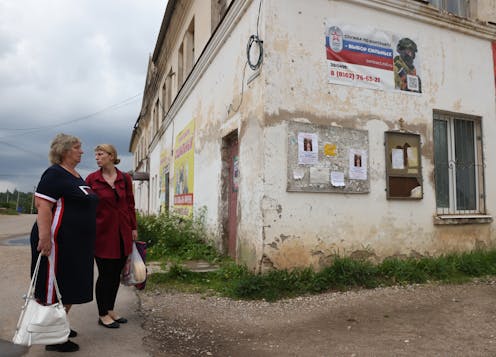Empire building has always come at an economic cost for Russia – from the days of the czars to Putin's Ukraine invasion
- Written by Christopher A. Hartwell, Professor of International Business Policy, ZHAW School of Management and Law

President Vladimir Putin’s invasion of Ukraine has come at huge economic costs. By conservative estimates, the Russian economy has taken a US$67 billion[1] annual hit as a result of war expenses and the effects of economic sanctions. In the early stages of the invasion, some analysts put the costs even higher, at $900 million per day[2].
These war costs show no sign of abating. The newly released Russian government budget for 2024 calls for a 70% defense expenditure increase, an astonishing reallocation[3] of precious resources for a war that some observers expected to last a week[4] at most.
Despite the toll of war and sanctions, the Russian economy has not collapsed[5] and seems to have proven somewhat resilient against being shut out of global value chains[6].
Indeed, if you were to tune in to broadcasts of state-run RT television’s “CrossTalk”[7] with American host Peter Lavelle, you’d be reassured that hardly anyone notices “irrelevant” Western sanctions, with even some reputable Western economists[8] claiming that sanctions are harming Europe more than Russia.
Certainly, Muscovite oligarchs can still stroll across Red Square to Agent Provocateur and the GUM luxury shopping mall[9] to buy lingerie for their wives and perhaps mistresses, too. And almost 8 in 10 Russians report to pollsters[10] that sanctions have not affected their daily lives.
But from our standpoint as experts on Russian[11] economic history[12], it looks very much like a Potemkin village[13] – a false facade that belies harsh economic realities, including unsustainable defense spending, a plummeting currency and rising bond yields. Meat and poultry prices in Moscow continue to rise[14], retail sales across Russia have dropped[15] by nearly 8% since February 2022, and Russia’s aviation industry has plummeted[16] for lack of spare parts and maintenance.
Such an economic hit was to be expected. As we show in a preprint study[17], imperial overreach from Russia in territories that are not its own has resulted in long-term damage to the Russian economy for over a century. More importantly, even during czarist times, rebellion in the modern-day lands of Ukraine against Russian rule led to the highest costs for the Russian economy.
Huge boost in military spending
Russia’s ability to seemingly absorb massive shocks since February 2022 is due in part to producers becoming accustomed to the milder sanctions that began in 2014[18] with the initial invasion of Ukraine and annexation of Crimea.
However, a larger driver of performance has been the Russian government taking it upon itself to try to keep the economy afloat by increasing its involvement in all sectors of the economy[19], nationalizing formerly Western-owned businesses[20] and pumping money from the state budget[21] into the military industrial complex[22].
This approach has continued with the Russian government’s 2024 budget[23], which is currently on its way to be rubber-stamped in the Russian parliament, the Duma. While mobilization of troops[24] for Russia’s growing quagmire is moving in fits and starts, the Kremlin has proceeded with a full-scale economic mobilization. Expenditures on defense are forecast to be 6% of the country’s GDP, making up a full 29% of all Russian government spending, according to an analysis by the Bank of Finland[25], and with an additional 9% spent on “national security.” In contrast, social programs are a mere 21% of the budget. Compare this with the United States, where defense spending is 3% of GDP and 12% of all government expenditures[26].
Financial markets have reacted poorly to Russia’s most recent imperial adventure. The ruble’s turbulence is well known, once again breaking 100 rubles to the dollar[27] on Oct. 3, 2023, but Russia’s inability to service its debt[28] has been more under the radar.
For the first time since the Bolsheviks refused to honor the country’s foreign debt in 1918, Russia defaulted on its foreign currency payments[30] in June 2022, and major ratings agencies stopped rating Russian government bonds.
At the same time, bond yields on existing Russian government debt – an excellent measure of fiscal risk – have been climbing almost continuously since the first invasion of Ukraine in 2014, rising to nearly 14% in 2014 and recently climbing to over 13%, an 18-month high[31].
Ponzi-like scheme
The combination of military aggression, stretched finances and battlefield stagnation are nothing new for Russia, especially in Ukraine. As our study shows, czarist fiscal management from 1820 to 1914[32] was based on a Ponzi-like scheme that funded land grabs and military expansion with government borrowing through bond issues, taxation of newly acquired territories and bond repayment by a government now overseeing a more geographically extensive state.
By 1914, Czar Nicholas II had bonds worth more than $155 billion in 2022 dollars trading abroad – by comparison, the value of British debt in 1914[33] equates to approximately $123 billion today.
Vladimir Putin’s handling of the economy since the early 2000s has been based on a similar pyramid scheme, we would argue. A combination of aggressive foreign borrowing and natural resource exports have financed foreign wars and domestic repression in territories of Russia’s near abroad: These have included conflicts in Chechnya[34] and Georgia[35] in the 2000s; Crimea and the Donbas[36] in the 2010s; and the rest of Ukraine in the 2020s. Until this current round of aggression toward Ukraine, the outcome of these conflicts appeared to favor Russia, with its seemingly strong central government, military and economy.
However, Russia may now be at an inflection point. Historically, when Russia’s military was successful, it was able to finance both its war machine and industrialization.
Yet even past military success put the regime on very shaky ground that allowed small setbacks to threaten its foundation. Military reversals such as the stunning loss to Japan in 1905[37] or even the costs associated with pacifying troublesome territories such as in the Caucasus[38] created more difficulties and risk for Russian bond markets and its economy. Indeed, unrest, armed rebellion and serf revolts in the far reaches of the empire raised Russian bond yields by approximately 1%. This risk was much higher than if such unrest occurred even in St. Petersburg or Moscow.
And perhaps most importantly, in Ukraine the cost of empire during czarist times was the largest, with each rebellion or bout of unrest in Ukraine raising Russian yields by between 3% and 3.5%.
With its newest defense budget going “all in[39]” on its already faltering invasion of Ukraine, Russia appears to have learned none of the lessons of its past. Then as now, Ukraine and Ukrainian defiance constituted a grave threat to Russian territorial ambitions.
In 2024, that defiance just might prove too determined and too costly for an increasingly fragile Russian economy. And as in 1917, the consequences could be far beyond the control of the modern-day czar[40] in the Kremlin.
References
- ^ US$67 billion (www.economist.com)
- ^ at $900 million per day (www.newsweek.com)
- ^ an astonishing reallocation (www.reuters.com)
- ^ expected to last a week (theintercept.com)
- ^ Russian economy has not collapsed (www.economist.com)
- ^ resilient against being shut out of global value chains (www.ft.com)
- ^ “CrossTalk” (www.rt.com)
- ^ Western economists (www.cirsd.org)
- ^ Agent Provocateur and the GUM luxury shopping mall (www.dailymail.co.uk)
- ^ report to pollsters (globalaffairs.org)
- ^ experts on Russian (scholar.google.com)
- ^ economic history (law.umn.edu)
- ^ Potemkin village (www.britannica.com)
- ^ continue to rise (www.nytimes.com)
- ^ retail sales across Russia have dropped (www.economicsobservatory.com)
- ^ Russia’s aviation industry has plummeted (www.airport-technology.com)
- ^ preprint study (doi.org)
- ^ began in 2014 (www.nato.int)
- ^ involvement in all sectors of the economy (www.bloomberg.com)
- ^ nationalizing formerly Western-owned businesses (www.themoscowtimes.com)
- ^ pumping money from the state budget (www.nytimes.com)
- ^ military industrial complex (www.oxfordreference.com)
- ^ Russian government’s 2024 budget (www.reuters.com)
- ^ mobilization of troops (www.themoscowtimes.com)
- ^ according to an analysis by the Bank of Finland (www.bofit.fi)
- ^ 12% of all government expenditures (www.pgpf.org)
- ^ breaking 100 rubles to the dollar (www.nytimes.com)
- ^ inability to service its debt (www.bbc.com)
- ^ Kirill Kudryavtsev/AFP via Getty Images) (www.gettyimages.com)
- ^ Russia defaulted on its foreign currency payments (www.weforum.org)
- ^ an 18-month high (tradingeconomics.com)
- ^ czarist fiscal management from 1820 to 1914 (doi.org)
- ^ value of British debt in 1914 (www.elibrary.imf.org)
- ^ conflicts in Chechnya (ciaotest.cc.columbia.edu)
- ^ and Georgia (www.atlanticcouncil.org)
- ^ Crimea and the Donbas (www.rand.org)
- ^ loss to Japan in 1905 (academicworks.cuny.edu)
- ^ in the Caucasus (www.armyupress.army.mil)
- ^ going “all in (www.wsj.com)
- ^ the modern-day czar (time.com)







